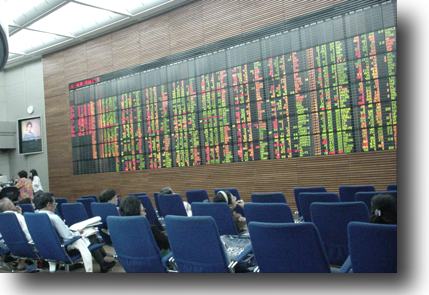Big returns in small stocks. The long record.
Here is the first of a two part article on why small caps" not only outperform the general market over time, but their low correlation to other investments make these stand out even more.
Smaller Thai stocks taste great and are less filling.
A superior long term performance record, when sorted by market capitalizations. And why this is magnified on the stock exchange of Thailand.
One of the core beliefs of mine since the very first day of publishing viewpoints at thaistocks.com, starting in 1997, has been the strong observation that smaller capitalized stocks often beat market the local averages -and that this bias is especially so magnified on the Stock Exchange of Thailand (SET).
Such "Micro cap" stocks, as more evolved times now prefer to call these, are classified in the US as companies which are market capitalized at less then 200 Mill US$. There is much good evidence there which unquestionably proves that smaller capitalized shares not only outperform (more on this below) yet, just as importantly are overall not much related to the general market index movements.
In investment theory, as in chemistry, "mixing of two elements" can create a formidable combined new desirable element. It was been well established for many decades -and so proven in modern portfolio theory- that combining differently moving stocks leads to a superior return, in a diversified portfolio. (Beta is the historical volatility rating, a sort of rating on the stocks past volatility and smaller cap stocks have often very low beta ratings).
Even very large global portfolios know well and have so recognized the critical need to have some percentage of their capital invested into Mico cap"s. shares. There are large advantages along with one key major disadvantage. Its that pervasive "liquidity factor" which however is so very relative to whom is doing the investing. A 1 Bill US$ portfolio cannot (or can barely) invest in many small/micro cap shares, as the funds liquidity requirement per stock selection is massively different then that of an individual investor. Large pools of funds understand very well this silent disadvantage -due only to their big size.
In Thailand this smaller/micro cap performance advantage, mostly benefiting individual investors, is magnified by a multiple factor as I have amply shown over the years at the web site thaistocks.com.
While this old saying can be true: "a bargain which stays a bargain, is no bargain", I would add this Wall Street proverb: "when everyone is thinking the same way, no one is thinking." On the SET investment rationale is often monotone. Investors are increasingly realizing that a bargain which remains a bargain can be in fact a bargain, that is if it pays unusually high and tax favored dividend yields some in the double digit level. And many do.
Any asset is defined as something which can produce periodic income and on the Thai stock exchange there are many high income producing stocks to be had, that is, as long you look beyond the daily volume leaders.Micro cap and smaller cap stocks are the return leaders over time. Here is the long record to superior investment performance.
Back to my initial claim that across the board various studies show, that over time and on average, smaller cap stocks outperform larger cap shares. This is so even so in far more shrewdly and broadly analyzed stock markets, like in the US.
It has been documented that one US dollar invested in micro caps stocks in 1926 would have grown to $5,865 by the end of 2002, while the same dollar invested in the S & P 500 (a large cap and broad US stock index) would have grown to just $1,226 *
Then there is a famous Merrill Lynch, US"s largest brokerage firm, broad historical study on risk/return characteristics, all by market capitalization. This study followed a large universe of 6000 stocks on a quarter by-quarter-basis. Here is the summary:
Risk/return characteristics by market capitalization, 1974-1993
Market Cap |
Annual Return |
Standard Deviation |
Sharp Ratio |
|
Large Cap |
11.0% |
15.9% |
0.691 |
|
Mid Cap |
14.3% |
17.3% |
0.827 |
|
Small Cap |
15.4% |
19.1% |
0.806 |
|
Micro Cap |
19.0% |
23.4% |
0.812 |
The sharp ratio is simply the amount of return achieved for each unit of risk or standard deviation undertaken. So, even adjusted for volatility (defined as risk) micro cap and small cap stocks provided substantially better returns over time. An investment which yields 19% annual returns will double in value in 4 years. The same which yields only 11% in annual returns will take 7 years to double. Over a period of two to three decades, or say a lifetime, the difference in capital growth becomes enormous.
And yet micro cap returns have shown here as in the US to have low correlation to mid cap and other broad stock indexes. This makes smaller cap shares an excellent diversification tool in the context of a multi-asset class portfolio.
The other thing to note is that the past century was marked by 2 world wars, various energy crisis and several dire economic recessions besides at times corrosive inflation. The period from 1974 to 1993 was at times a turbulent period, notable the horrific stagflation and hyper high interest rate environment of the late 70"s and early 1980"s.
To my knowledge, nothing coming even close has been studied on the Thai stock exchange regarding this investor advantage. No broker research report as ever shown performance returns simply sorted by the size of their market capitalization. Ask yourselves why?
It does not matter, as thaistocks.com since 1997 has demonstrated again and again, that over time smaller cap SET shares return considerably more to investors in capital gains and dividends. While smaller cap SET and US shares provide a substantial performance advantages over time, there are clearly peaks and troughs along the way.

Reasons why the small cap performance advantage is magnified on the SET:
There are specific reasons why the investment performance advantage is most likely magnified on the Thai stock exchange. For starters, broker stock research analysis forever dwells on largesse and can bias views instead of more reporting of what the many listed companies actually tell them. Only a select few, smaller cap stocks are in the brokers universe -while hundreds of others are just ignored, no matter how good earnings, dividends and relative valuations. Add to this the entrenched local trading mentality, so dominant here, and you have the best possible cocktail mix to strong market pricing inefficiencies.
In the US, often smaller growth stocks as I am comparing here, almost always trade at premium to general market valuations. (This is perfectly rational, as a company which is growing twice as fast as another, should have three times the stock valuation. (This can be proven in finance math). Further, smaller growth stocks in the US rarely pay any cash dividends. Rightly so, as the fast growth rate justifies the company to keep the capital in house so to finance high future expected growth rates. Not so here by any standard.
On the Thai stock exchange, smaller faster growing companies almost always trade at a nice valuation discount to their large peers -and on top often pay far higher dividend yields, as compared to large cap averages. As in the US, I have often noted over many years that most smaller cap SET shares do not "dance" along with the considerable gyrations of the SET index, again this is a hidden advantage.
So with all this you might ask: what is the investor catch? Well, due to the lack of more local broker research on these, there is a lack of securities information on most. Yet, this shortcoming is also the advantage, as for those whom do their home work there are some real bargains, which go begging.
It is noteworthy that on the SET many of these so called small cap or micro cap stocks are in fact leaders in their respective industries -and so this is the icing on the cake.
Thailand is a global competitor in a number of key industries, yet these solid firms/leaders are not on the radar screens of most sophisticated investors.
Paul A. Renaud.
* The Micro Cap Investor. Strategies for Making big returns in small companies.
By Richard Imperiale. Published by Wiley Trading. 2005

